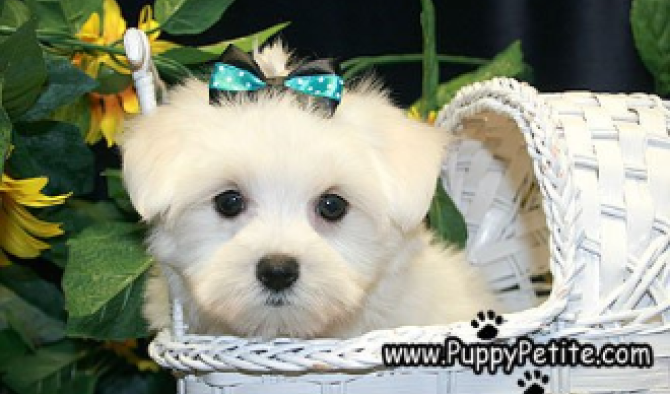

- Phone
- Email puppypetite@aol.com
-
Address
8002 17th Ave, Brooklyn NY 11214

How To Crate Train A Maltese Puppy
Crate training is a method of house training employed by pet owners to instill discipline and create a safe space for their pets. For Maltese puppies, crate training plays several vital roles:
- Security and Comfort: A crate can provide a sense of security and comfort for your Maltese puppy, serving as a personal space where they can retreat and relax.
- Toilet Training: Crate training helps in establishing a consistent toilet routine, as dogs naturally avoid soiling their living spaces.
- Prevent Destructive Behavior: By providing a confined space, crate training can prevent or mitigate destructive behavior (like chewing furniture) when puppies are left alone at home.
- Ease of Travel: A crate-trained puppy will feel more comfortable during travel, making trips a less stressful experience for both the pet and owner.
- Recovery Aid: In case of injury or surgery, a crate provides a controlled environment that aids in recovery by limiting a puppy's movement and activities.
Crate training is an influential tool for puppy development, fostering a sense of security, promoting good behavior, and easing travel-related stress. Moreover, it serves as a beneficial aid during recovery from injury or surgery. Utilizing this method responsibly can significantly enhance your Maltese puppy's overall well-being and quality of life, while also promoting a harmonious coexistence within your household.


Breed Introduction: Maltese Puppy Overview
The Maltese is an enchanting breed, renowned for its playful personality, graceful elegance, and glamorous, silky white coat. Originating from the central Mediterranean island of Malta, these dogs have a rich history, dating back over 2000 years, and are considered one of the oldest toy breeds.
- Appearance: A Maltese puppy is small with a strong, compact body. The dog's most prominent feature is its long, flowing, silky white hair, which requires daily grooming to maintain its stunning appearance. They have dark, round eyes that exude a sweet and loving expression, along with black noses and lips.
- Temperament: Maltese puppies are renowned for their cheerful, sociable, and affectionate nature. They enjoy being the center of attention and are known for their ability to form strong bonds with their owners. Despite their small size, Maltese dogs are fearless and make excellent watchdogs.
- Health: Maltese puppies are generally a healthy breed. However, they may be prone to certain health conditions such as dental issues, heart issues, and patellar luxation. Regular veterinary checks and a balanced diet can help keep these health issues at bay.
- Training: Maltese puppies are intelligent and quick to learn. They respond well to positive reinforcement techniques and require consistent training from a young age. As with any breed, early socialization is crucial for ensuring a well-behaved and well-adjusted dog.
- Exercise: Despite their small size, Maltese puppies have a fair amount of energy. Regular short walks, play sessions, and mental stimulation are necessary for their well-being. However, care should be taken not to overexert them due to their delicate structure.
- Life Span: The Maltese breed typically has a long lifespan, often living up to 15 years or more, with proper care and a healthy lifestyle. Their longevity makes them a great companion for many years to come.
Maltese puppies are delightful pets, loved for their beauty, amiable temperament, and loyalty. They require a dedicated owner willing to invest time in grooming, training, and nurturing. With appropriate care and attention, these charming little dogs can make a wonderful addition to any home, providing years of companionship and joy.

Steps in Crate Training Your Maltese Puppy
Initiating crate training for your Maltese puppy can seem intimidating at first, but by following systematic steps, it can become a stress-free and beneficial process for both you and your pet. Here are some key steps to undertake in this journey of crate training:
- Picking the Right Crate: The first step in crate training is selecting a suitable crate. It should be large enough for your puppy to stand, turn around, and lie down comfortably, but not so large that they might use part of it as a toilet area.
- Introducing the Crate: Place the crate in an area where your family spends a lot of time and keep the crate door open. Encourage your puppy to explore the crate on their own with the aid of toys or treats.
- Feeding Meals in the Crate: Begin to serve your puppy's meals inside the crate. This associates the crate with positive experiences.
- Gradually Increasing Crate Time: After your puppy is comfortable eating meals in the crate, start to close the door while they eat, gradually increasing the length of time the door stays closed after meals.
- Crate Training at Night: Once your puppy is comfortable with the crate, start using it for overnight sleep. This will help further instill a sense of security and routine.
- Leaving the Puppy Alone in the Crate: When your puppy is comfortable staying in the crate for about 30 minutes after eating, you can start leaving them alone in the crate for short periods while you leave the house.
Remember, crate training is a process that requires time, patience, and consistency. It's important not to rush the process and to always associate the crate with positive experiences. With persistence and the right approach, your Maltese puppy will soon view the crate as a safe and comfortable space. Having successfully crate-trained your puppy, you've effectively laid the foundation for a more secure, disciplined, and stress-free cohabitation.
Bedding and Comfort Items for Crate Training
Creating a comfortable and inviting environment within the crate can significantly ease the crate training process. An important part of establishing this environment involves selecting the right bedding and comfort items. These elements not only make the crate more appealing but also contribute to the overall well-being and contentment of your Maltese puppy. Let's delve into the significance and process of choosing these crucial components:
- Choosing the Right Bedding: Bedding plays a crucial role in providing a soft, comfortable surface for your puppy to rest on. As Maltese puppies have short coats, they may feel cold easily, therefore, a warm and cozy bed is essential. Start with something simple and durable. Be aware that some puppies may chew their bedding, so it's important to monitor this and opt for chew-resistant options if necessary.
- Adding Comfort Items: Including a few comfort items in the crate can make it more welcoming and enjoyable for your puppy. These could be chew toys, stuffed animals, or even a worn piece of your clothing. These items can provide amusement, comfort, and a sense of familiarity. But ensure they are safe and cannot be easily torn apart to avoid any choking hazards.
- Placement of Water and Food Bowls: If your puppy is to spend a considerable time in the crate, consider investing in clip-on water and food bowls. These bowls should be sturdy and not easily tipped over. They will be at a height that your puppy can comfortably access, and because they attach to the crate, you'll avoid any messy spills.
- Temperature Regulation: Depending on the climate, your puppy may need additional items for warmth or cooling. A blanket can provide extra warmth in colder climates, while a cooling mat can be beneficial in hotter areas.
Choosing the right bedding and comfort items for your Maltese puppy's crate is essential for successful and stress-free crate training. Remember, the objective is to make the crate a safe, comfortable, and enjoyable space for your puppy. Therefore, it's important to select items that suit your puppy's needs and preferences. Once this is achieved, crate training becomes a much simpler and more rewarding experience for both owner and puppy alike. With patience and consistent efforts, your Maltese puppy will soon view the crate as their personal haven, paving the way for a harmonious living environment.
